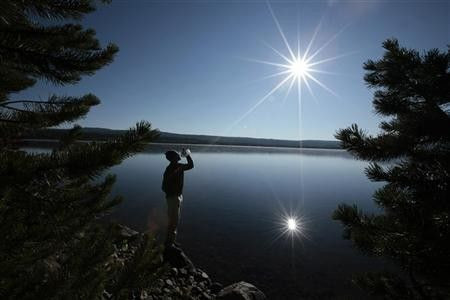Climate change threatens Yellowstone region

A warming climate is imperilling the wildlife and landscapes in the Yellowstone National Park region, two environmental groups said in a study.
The report by Rocky Mountain Climate Organization and Greater Yellowstone Coalition shows temperatures in the past decade in the Yellowstone area have exceeded the rate of warming worldwide compared to the 20th Century average.
Left unchecked, climate change is likely to transform the greater Yellowstone area, which includes parts of Wyoming, Idaho and Montana and encompasses two national parks, six national forests and three wildlife refuges, the report said.
The Yellowstone National Park region is one of the world's last largely intact temperate ecosystems.
Threads are already being pulled out of the glorious tapestry that is the greater Yellowstone ecosystem and it has lost some of its luster, said Stephen Saunders, president of the Rocky Mountain Climate Organization and an author of the report. It's up to us to preserve this marvellous, magical place for future generations.
The Rocky Mountain Climate Organization is a nonprofit group working to reduce climate disruption and its impact on the interior West and the Greater Yellowstone Coalition is a conservation organization that works to protect the lands, waters and wildlife of the greater Yellowstone ecosystem.
Warming in the area could increase the frequency and severity of wildfires, strip forests of moisture-dependent trees such as aspen, lower water in mountain streams with world-class trout fisheries and damage areas vital to threatened species such as grizzly bears, the study suggests.
A worst-case projection shows summertime temperatures at Yellowstone National Park soaring by as much as 10 degrees Fahrenheit by 2099, according to an analysis in the report of government weather data and modelling by top climate scientists.
That would mean future summers as hot as the Los Angeles metropolitan area have been in recent years, Saunders said during a telephone news conference.
Sweltering summers and dry winters would be devastating to already ailing alpine trees such as whitebark pines, which produce nuts crucial for grizzlies, and rare, snow-dependent animals such as the Canada lynx, said Saunders, former deputy assistant secretary for the U.S. Interior Department.
The report, which relied on peer-reviewed research by government and university scientists, should serve as a wake-up call about the Yellowstone area, said Scott Christensen, climate director with the Montana-based Greater Yellowstone Coalition and a co-author of the study.
Failing to reverse the trend could damage the region's $700 million annual tourism economy, the authors said.
© Copyright Thomson Reuters {{Year}}. All rights reserved.





















